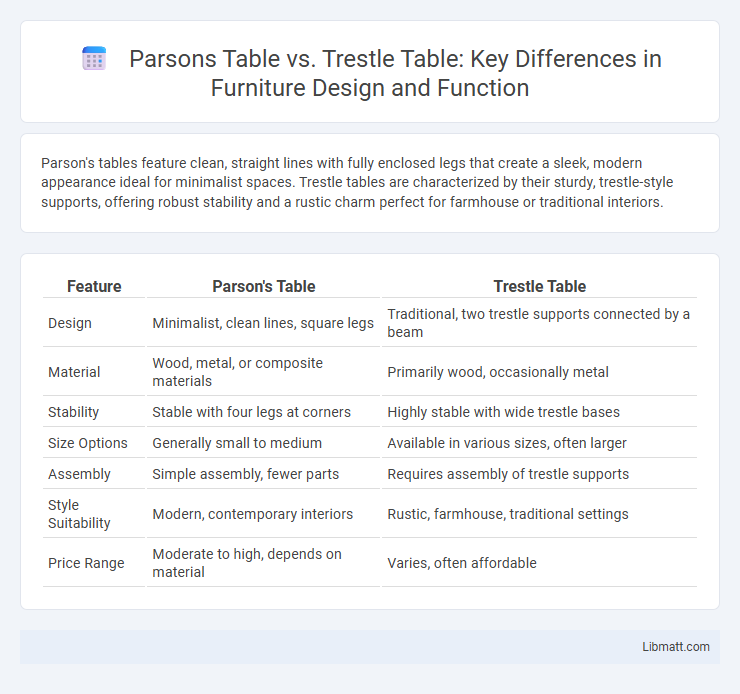Parson's tables feature clean, straight lines with fully enclosed legs that create a sleek, modern appearance ideal for minimalist spaces. Trestle tables are characterized by their sturdy, trestle-style supports, offering robust stability and a rustic charm perfect for farmhouse or traditional interiors.
Table of Comparison
| Feature | Parson's Table | Trestle Table |
|---|---|---|
| Design | Minimalist, clean lines, square legs | Traditional, two trestle supports connected by a beam |
| Material | Wood, metal, or composite materials | Primarily wood, occasionally metal |
| Stability | Stable with four legs at corners | Highly stable with wide trestle bases |
| Size Options | Generally small to medium | Available in various sizes, often larger |
| Assembly | Simple assembly, fewer parts | Requires assembly of trestle supports |
| Style Suitability | Modern, contemporary interiors | Rustic, farmhouse, traditional settings |
| Price Range | Moderate to high, depends on material | Varies, often affordable |
Introduction to Parson’s Table and Trestle Table
Parson's Table features clean, straight lines with legs that are flush with the tabletop edges, offering a sleek and modern aesthetic ideal for contemporary interiors. Trestle Tables consist of a flat top supported by two or more trestle legs, providing strong structural support and a rustic, traditional charm. Your choice between Parson's and Trestle Tables depends on whether you prefer minimalist design or classic sturdiness for your dining or workspace.
Historical Origins and Development
The Parson's Table originated in the early 20th century, designed to offer a clean, minimalist aesthetic with straight lines and a uniform thickness for legs and tabletop, reflecting the modernist movement's emphasis on functionality and simplicity. The Trestle Table has much older origins dating back to medieval Europe, characterized by a movable frame consisting of two or more trestle supports with a flat tabletop, enabling easy disassembly and flexible use in large communal or banquet settings. Both tables evolved to meet changing social needs: Parson's Table embraced urban modern living's demand for versatile, space-saving furniture, while the Trestle Table persisted in rustic and traditional environments due to its sturdy design and practicality.
Key Design Features
Parson's Table features a minimalistic design with clean lines and thick, squared legs that are flush with the table edges, creating a streamlined and modern look. Trestle Table is characterized by its sturdy support structure with two or three trestle legs connected by a horizontal beam, offering a rustic and traditional aesthetic. The key distinction lies in Parsons' emphasis on simplicity and uniform leg placement, while Trestle highlights functional support and visual weight through exposed beams.
Structural Differences
Parson's Table features a minimalist design with a thick tabletop supported by square, straight legs positioned flush with the edges, creating a clean, boxy silhouette. In contrast, a Trestle Table is defined by its two or more trestle supports connected by a horizontal beam, allowing for open leg space and enhanced stability. These structural differences impact both the aesthetic appeal and functional versatility of each table style.
Aesthetic Appeal and Styles
Parson's Table is characterized by its clean, straight lines and minimalist design, making it a popular choice for modern and contemporary interiors seeking a sleek aesthetic. Trestle Tables feature a more traditional and rustic look, often showcasing sturdy, exposed supports that add a handcrafted charm suitable for farmhouse or vintage styles. Both table types enhance spaces differently: Parson's Table emphasizes simplicity and geometric form, while Trestle Tables contribute warmth and architectural interest.
Material Choices
Parson's tables typically feature sleek, clean lines and are often crafted from hardwoods like oak, walnut, or maple for durability and a modern look. Trestle tables are commonly made from solid wood such as pine, cedar, or reclaimed wood, emphasizing rustic charm and sturdiness. Your choice between these tables will depend on the preferred material's texture, finish, and overall style to complement your space.
Versatility and Functionality
Parson's tables feature clean, minimalist designs with uniform legs positioned at the corners, providing versatile functionality suitable for modern dining, workspaces, and minimalist interiors. Trestle tables, characterized by their sturdy central support beams, offer flexible adaptability for larger gatherings or variable seating arrangements, enhancing usability in both traditional and contemporary settings. The choice between these tables hinges on spatial needs and multifunctional demands, with Parson's tables excelling in compact, sleek environments and trestle tables prioritizing stability and expandability.
Durability and Stability
Parson's tables feature a solid, box-like frame that enhances durability by providing consistent support along the entire structure, making them less prone to wobbling. Trestle tables rely on two or more trestle supports connected by a stretcher, which offers excellent stability but may be more susceptible to side-to-side movement if not properly secured. Both table types use sturdy hardwoods for construction, but Parson's design generally offers superior long-term stability in high-traffic environments.
Ideal Uses and Placement
Parson's Tables with their sleek, minimalistic design are ideal for modern dining spaces, home offices, or as versatile accent tables in living rooms due to their clean lines and compact footprint. Trestle Tables, characterized by sturdy trestle legs and often larger surfaces, are best suited for communal dining areas, rustic kitchens, or workspaces that require robust support and spacious layouts. Both table types complement various interior styles but choosing between them depends on the balance between aesthetic preference and functional space requirements.
Choosing the Right Table for Your Space
Parson's tables feature clean, straight lines and a sleek design that fits perfectly in modern, minimalist spaces, while trestle tables offer sturdy, rustic charm with their robust legs and traditional craftsmanship. Consider your room's size and style: Parson's tables excel in compact areas due to their streamlined profile, whereas trestle tables provide ample legroom and a stable base, ideal for larger dining rooms or multipurpose areas. Your choice depends on whether you prioritize a contemporary aesthetic or timeless durability to complement your space efficiently.
Parson’s Table vs Trestle Table Infographic

 libmatt.com
libmatt.com